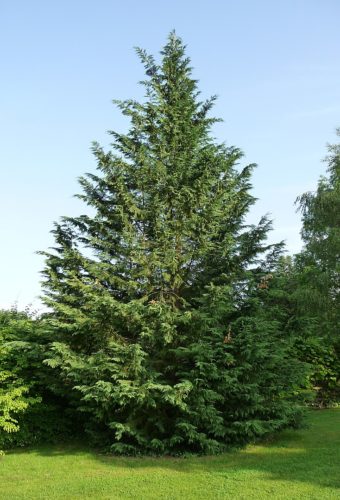Leyland cypress is a fast-growing conifer belonging to the cypress family.
Also known as:
Leylandii
You are viewing the mobile-adapted version of the page.
The one for tablets, laptop and desktop also provides general information, such as origin, toxicity and cultivation.
Leyland cypress – (Cupressocyparis leylandii), a fast-growing conifer belonging to the cypress family (Cupressaceae). The Leyland cypress originated from two different species of cypress trees from the western coastal regions of North America. The Leyland cypress is evergreen and hardy.
A Leyland cypress can easily grow 70 to 80 cm per year in a good location and is therefore a widely planted hedge plant. A hedge with Leyland cypresses can grow seven to eight meter tall in ten years. To keep the hedge in shape, pruning (“shearing”) with a hedge trimmer twice a year is necessary. May and September are the best months for pruning. Do not prune the hedge down to the bare wood; Leyland cypresses no longer sprout on the bare wood.
Always prune so that the top is narrower than the bottom: that way the bottom of the hedge does not end up in its own (rain) shade and become top-heavy. Frequent pruning removes many nutrients from the soil; regular (spring) fertilizing keeps the hedge healthy.
Leyland cypresses grow best in well-drained soil; they do not like wet feet. This hedge plant can be planted in both full sun and (semi-)shade. Do not plant them in deep shade, or the foliage will turn brown. Leyland cypresses, unlike Yew, do not live forever: after ten to twenty years – depending on the location – they begin to languish and need to be replaced.
Prevent the Leyland cypress from drying out during dry periods, water regularly.
Bugs
Branches of the Leyland cypress turn brown: cypress aphid (Cinara cupressi).
Fungi & diseases
During humid periods, branches turn brown, sometimes grey fungal fluff can be seen: gray mold (Botrytis ssp.). Severely weakened Leyland cypresses (pruned too rigorously and/or too often) can also be affected.
Other
The foliage of the Leyland cypresses turns yellow from the underside: too little water. Leyland cypresses that are in too wet soil show the same symptoms because the roots rot, which means that the Leyland cypress can absorb less water and consequently dries out.
Brown dots on the ends of branches: blunt pruning tools, cutting the green raggedly. Or the pruning took place in late fall or winter, causing the pruned foliage to die due to cold.

